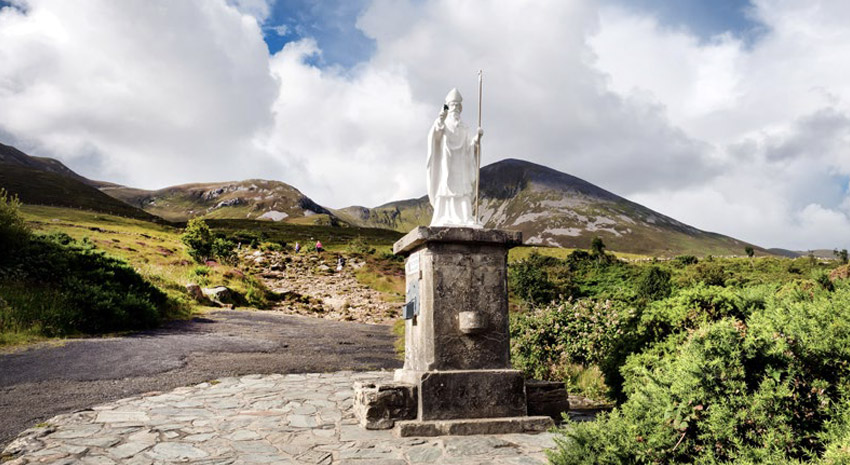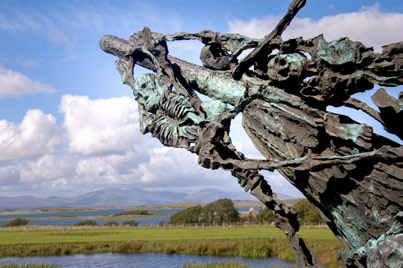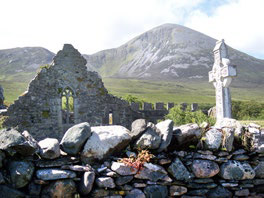Ireland, May 2018

Photo: © FRANK BACH | DREAMSTIME.COM
I HAVE TO CONFESS, CROAGH PATRICK is still on my bucket list. Rising on Ireland’s northwest coast right beside the sea in County Mayo, the stately mountain — actually a high hill — is one of the island’s sacred spots. Back in the year 441, St. Patrick is said to have fasted there 40 days and 40 nights, interrupting his vigil to drive all the snakes into the sea. The ascent has become a pilgrimage site for devoted Catholics, some said to make the ascent barefoot or on their knees. It’s also a popular destination for hikers and for hardy locals who jaunt up once or twice a week just for exercise.
In pilgrimage season, April through October, the mountain can be mobbed with a few hundred people a day sauntering up and back, children holding their parents’ hands, joggers skipping from rock to rock. I’ve summited Kilimanjaro and trekked up to Everest Base Camp, so I figured this glorified hill would be a bit of a jaunt. A tendon in my heel was still sore after a recent curb misstep, but I expected a mere bit of discomfort as I strolled up what I assumed would be a gentle path.
Not exactly. Once I passed the Visitor Centre and statue of St. Patrick and climbed a short flight of stairs, reality set in. Hundreds of pilgrims and hikers eroded the path into a rough surface of loose stones scattered around protruding rocks. There was no clear footing, especially since I was favoring my tender ankle. For a few euros, climbers can buy or rent a recommended hiking stick at the bottom, but I had brought along the cane I’d been using to help my ankle injury. Even with that extra support, it was slow going.

FAMINE MONUMENT SCULPTURE © VINCENT MACNAMARA | DREAMSTIME.COM
It might have helped if I could see where I was headed. The path veers east off to the left before turning west up to the peak. But the customary mist had settled in, and clouds secluded Croagh Patrick’s upper reaches. Nor was there any sight of the intermediate destinations along the way.
Climbers first reach a rest stop, described matter-of-factly as “the toilets.” Farther along at the first station, a pile of stones, the prescribed ritual is to walk seven times around the cairn which commemorates the bones of St. Patrick’s follower Benain, attacked by blackbirds on the spot. The second station is the actual hilltop, with a small chapel which seats a few dozen worshipers and offers views of the meadows and stone fences to the east and the 300 Aran islands dotting the shore below. The truly committed descend 500 feet down the west slope to a third station, cairn Reilig Mhuire, which calls for its own recitations of homilies and prayers before a climb back up to the summit to turn around and return the way you came.
I have yet to pay my devotions at any of those spots. After hobbling along for more than an hour, I encountered fellow climbers who turned back since “the weather was worsening and the last part of the climb, to the cone, is the hardest.”
I hate to be a quitter, and I hadn’t even reached “the toilets.” But I was worried about slipping down the loose gravel, and, sure enough, once I turned back, the downhill slide was harrowing. Seeing my dilemma, a kindly little girl on the trail donated her stick to help me balance. Without that gift I might have had to call a rescue squad. As it was, with the cane and stick propping me up, balanced between them, I took two hours to inch back down.

RUINS OF MURRISK ABBEY © TIMOTHY KIRK | DREAMSTIME.COM
I’ve vowed to return. Not only do I have to fulfill my “bucket list” assignment, but the region is rich in tourist activities. At the foot of the mountain, a ghostly Famine Monument portrays the coffin ships that brought immigrants to America. The stone ruins of Murrisk Abbey on the site of St. Patrick’s church retain the frame of a oncegrand window.
For hikers and cyclists, the Great Western Greenway, a converted rail trail, winds 26 miles from Achill Island to the charming riverside town of Westport, where visitors can shop for hand-knit sweaters and shamrock key chains in stores retaining their vintage façades. A guided visit through the 30 period rooms of stately Westport House illustrates the lifestyle of bygone gentry.
Westport Harbour hotels offer spa treatments, dining and dozens of atmospheric pubs. Travelers can book tours with local outfits to nearby Clare Island to see the castle of 16th-century pirate queen Grace O’Malley or arrange trips for fishing, cycling, kayaking and heritage walks. I’m looking forward to trying out some of the options when I return next spring to conquer Croagh Patrick, once and for all.
